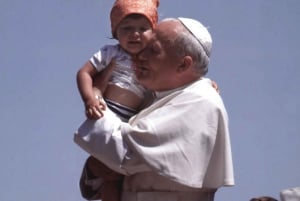
From Krakow: In the Footsteps of John Paul II
12 ReviewsThe tour gives you a chance to follow in the footsteps of the man who was to become one of the greatest Popes and human beings in history.
A witness to the majority of Polish historical events, both of bygone and present era. Burial place of country's supreme leaders. Also a must for architecture fans. Get yourself a separate ticket to King's Tombs and Sigismund Bell climb.
The baptism of Poland and its rise as an important seat of Christianity is so closely linked to the nation's unity and cultural identity, that nothing could be more emblematic than the towers of Wawel Cathedral on Wawel Castle hill. For 400 years the cathedral of Polish kings, its vaults have seen the kingdom rise, fall, and rise again over the past millennium.
The earliest cathedral structure was raised not long after 1000AD, but was significantly rebuilt twice; remains of some of the earlier foundations can still be seen. Visible today is the richly remodeled 17th century interior, with its characteristic black and pink marble from local quarries.
The cathedral does not stand out for its design, however, but for its historical significance. Wawel cathedral first became a symbol of Polish unification when Wladyslaw Lokietek (the Short) brought the fragmented kingdom together and was crowned the first king of reunified Poland in the cathedral on 20 January 1320. From then on, Wawel cathedral was the site of royal weddings, baptisms, burials and coronations until the fall of the monarchy in the late 18th century. The royal tombs, located throughout the cathedral in specially built chapels, are in themselves works of art.
Wawel cathedral is not only the resting place of Polish monarchs, but also the pantheon of Polish heroes and a symbolic shrine to Poland's struggles for freedom. The first martyr to take his place within the cathedral walls was Saint Stanislaw, a bishop murdered by King Boleslaw the Bold in 1079 and canonized in 1253, who became the patron saint of the Polish monarchy; at his tomb Poles have gathered for centuries to pray for their fatherland, and Polish kings have placed trophy banners won in battle, among them the flag of the Teutonic Knights captured at Grunwald in 1410 and the Turkish flag taken at Vienna in 1683.
After Poland's loss of independence in 1795, Wawel Cathedral became a site of patriotic pilgrimage and a burial place for the national heroes Tadeusz Kosciuszko and Prince Józef Poniatowski, and later Marshal Józef Pilsudski and President Wladyslaw Sikorski. When poet Adam Mickiewicz's remains were transported from Paris in 1890, a Crypt of National Poets was created, underlining the important spiritual role of Poland's literary heroes in the fight for independence. Most recently, and amid great controversy, the late President Lech Kaczynski and his wife were laid to rest in the cathedral after their tragic death in the Smolensk plane crash of April 2010, symbolically representing all those who have given their lives for Poland's unity and freedom.
My Guide Krakow is part of the global My Guide Network of Online & Mobile travel guides.
We are now in 120+ Destinations and Growing. If you are interested in becoming a local travel partner and would like to find out more then click for more info about our Website Business Opportunity.
Filter Events by Sub-Category
Please select a Date first.